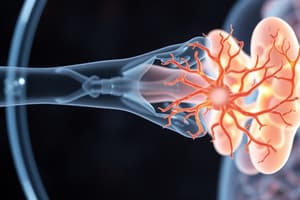Podcast
Questions and Answers
What is the relationship defined by the equation d = m/Vobj?
What is the relationship defined by the equation d = m/Vobj?
- Density is equal to pressure divided by volume.
- Density is equal to mass divided by volume. (correct)
- Density is equal to volume multiplied by mass.
- Density is equal to mass divided by pressure.
What can be inferred about the object if its density is known along with its mass?
What can be inferred about the object if its density is known along with its mass?
- The temperature of the object can be inferred.
- The volume of the object can be easily calculated. (correct)
- The pressure exerted by the object can be determined.
- The mass of the object can be found without further information.
In a scenario with a sample in a chamber, what must be constant to consider the runs identical?
In a scenario with a sample in a chamber, what must be constant to consider the runs identical?
- The density of the gas must remain the same.
- The temperature of the sample must change.
- The mass of the gas used must vary between runs.
- The pressurization and expansion cycles must be equal. (correct)
Which of the following best describes the purpose of knowing the density when it comes to volume calculations?
Which of the following best describes the purpose of knowing the density when it comes to volume calculations?
What type of cycles are involved in the two hypothetical runs discussed?
What type of cycles are involved in the two hypothetical runs discussed?
What is the purpose of a gas pycnometer?
What is the purpose of a gas pycnometer?
What law does a gas pycnometer operate under?
What law does a gas pycnometer operate under?
Which valve is used to provide gas to the sample chamber?
Which valve is used to provide gas to the sample chamber?
In which step of the pycnometer operation does gas expand to the reference chamber?
In which step of the pycnometer operation does gas expand to the reference chamber?
What happens to the gas after it has been depressurized in the pycnometer operation?
What happens to the gas after it has been depressurized in the pycnometer operation?
What does the pressure transducer measure at the end of the operation?
What does the pressure transducer measure at the end of the operation?
What is a key component of the gas pycnometer's design?
What is a key component of the gas pycnometer's design?
Which of the following valves remain closed during the expansion of gas to the reference chamber?
Which of the following valves remain closed during the expansion of gas to the reference chamber?
What condition must be assumed for the mass balance equations to be valid?
What condition must be assumed for the mass balance equations to be valid?
In the mass balance equation, what does the term 'Vobj' represent?
In the mass balance equation, what does the term 'Vobj' represent?
What is a necessary condition on pressure in equation (1) as described?
What is a necessary condition on pressure in equation (1) as described?
What variable does 'Pd' represent in the equations provided?
What variable does 'Pd' represent in the equations provided?
Which equation is used for calculating the object volume during the process?
Which equation is used for calculating the object volume during the process?
What must be true about the gas during the procedure concerning temperature?
What must be true about the gas during the procedure concerning temperature?
What does the variable 'Yr' likely represent in the mass balance equations?
What does the variable 'Yr' likely represent in the mass balance equations?
What is the primary purpose of using an absolute pressure transducer in the experiment?
What is the primary purpose of using an absolute pressure transducer in the experiment?
What must be known in order to calculate the volume of the object (Vobj) using the provided equations?
What must be known in order to calculate the volume of the object (Vobj) using the provided equations?
How does the absolute pressure measured by transducers compare to gauge pressure?
How does the absolute pressure measured by transducers compare to gauge pressure?
In the equation relating to the second experiment, what does the term 'Vsphere' represent?
In the equation relating to the second experiment, what does the term 'Vsphere' represent?
What is the purpose of conducting two independent experiments as mentioned in the content?
What is the purpose of conducting two independent experiments as mentioned in the content?
What can be derived from solving the two equations (3) and (4)?
What can be derived from solving the two equations (3) and (4)?
What is the significance of the Pa value being set to zero when using a gauge pressure transducer?
What is the significance of the Pa value being set to zero when using a gauge pressure transducer?
Which equation indicates the relationship involving the pressure differences in the second experiment?
Which equation indicates the relationship involving the pressure differences in the second experiment?
What factors are necessary to calculate the volume of an object using the given system of equations?
What factors are necessary to calculate the volume of an object using the given system of equations?
Flashcards
Mass balance equation
Mass balance equation
The equation stating that the amount of gas in a system remains constant, assuming no additional sources or leaks.
Vobj
Vobj
The volume of the object placed in the sample chamber.
Pp
Pp
Pressure of the gas in the object volume.
Pd
Pd
Signup and view all the flashcards
Working equation (equation 2)
Working equation (equation 2)
Signup and view all the flashcards
Gas expansion pycnometer
Gas expansion pycnometer
Signup and view all the flashcards
Atmospheric pressure
Atmospheric pressure
Signup and view all the flashcards
Absolute pressure transducer
Absolute pressure transducer
Signup and view all the flashcards
Gas Pycnometer
Gas Pycnometer
Signup and view all the flashcards
Gas Displacement Method
Gas Displacement Method
Signup and view all the flashcards
Ideal Gas Law
Ideal Gas Law
Signup and view all the flashcards
Sample Chamber
Sample Chamber
Signup and view all the flashcards
Reference Chamber
Reference Chamber
Signup and view all the flashcards
Pressure Transducer
Pressure Transducer
Signup and view all the flashcards
Pycnometer Operation Steps
Pycnometer Operation Steps
Signup and view all the flashcards
Absolute Pressure
Absolute Pressure
Signup and view all the flashcards
Gauge Pressure
Gauge Pressure
Signup and view all the flashcards
Pycnometer
Pycnometer
Signup and view all the flashcards
Two-Experiment Method
Two-Experiment Method
Signup and view all the flashcards
Solving Equations (3) and (4)
Solving Equations (3) and (4)
Signup and view all the flashcards
What is Vobj?
What is Vobj?
Signup and view all the flashcards
What is the 'working equation' in gas expansion pycnometry?
What is the 'working equation' in gas expansion pycnometry?
Signup and view all the flashcards
Density (d)
Density (d)
Signup and view all the flashcards
How is density used with gas expansion pycnometry?
How is density used with gas expansion pycnometry?
Signup and view all the flashcards
Study Notes
Gas (Helium) Pycnometer Theory
- A gas pycnometer measures the volume of materials using gas displacement and the ideal gas law (pV = nRT).
- It has a sample chamber and a reference chamber, often with multiple valves.
- Typical operation involves three steps:
- Pressurizing the sample chamber (valve 1)
- Expanding gas to the reference chamber (valve 2)
- Releasing gas to the atmosphere (valves 2 & 3).
- The pressure is measured using a transducer.
- The object's volume (Vobj) can be calculated using the formula: Vobj = Vc * ((Pd - Pa)/(Pp - Pd))
Pressure Transducer
- Atmospheric Pressure: An important value, often denoted as Pa.
- Pressure transducers measure pressure, crucial for accurate volume calculation.
- The transducer reads atmospheric pressure (Pa) after the gas is released.
- Different types of pressure transducers exist, including absolute and gauge types. Absolute types measure pressure relative to a vacuum; gauge types measure pressure relative to atmospheric pressure. Gauge readings need a correction of 101.325 kPa to compare with absolute pressure readings.
Operation Procedure
- Initial step involves pressurizing the sample chamber to a known pressure (Pp).
- Gas expands to the reference chamber, reaching the same pressure (Pd).
- Finally, the gas releases into the atmosphere, allowing measurement of ambient pressure (Pa).
Calculations
- Volume calculations relate the pressures and volumes at different stages of the process.
- Two independent experiments are needed for volume determination:
- One using an empty sample chamber.
- One using a known volume object.
- These calculations involve solving equations derived from the ideal gas law and using the known values for the experimental variables.
Density Calculation
- Density is calculated using the formula: Density = Mass/Volume.
- Determining the object's mass and calculated volume allows the calculation of density.
Calibration and Verification
- A calibrated object of known volume is used for calibrating the pycnometer apparatus.
- Calibration is done to ensure the accuracy of the measurements.
Pycnometer Application
- Used in laboratory or field to measure the volume of materials accurately.
- Applying physics principles to determine mass and volume of unknown objects.
Studying That Suits You
Use AI to generate personalized quizzes and flashcards to suit your learning preferences.




